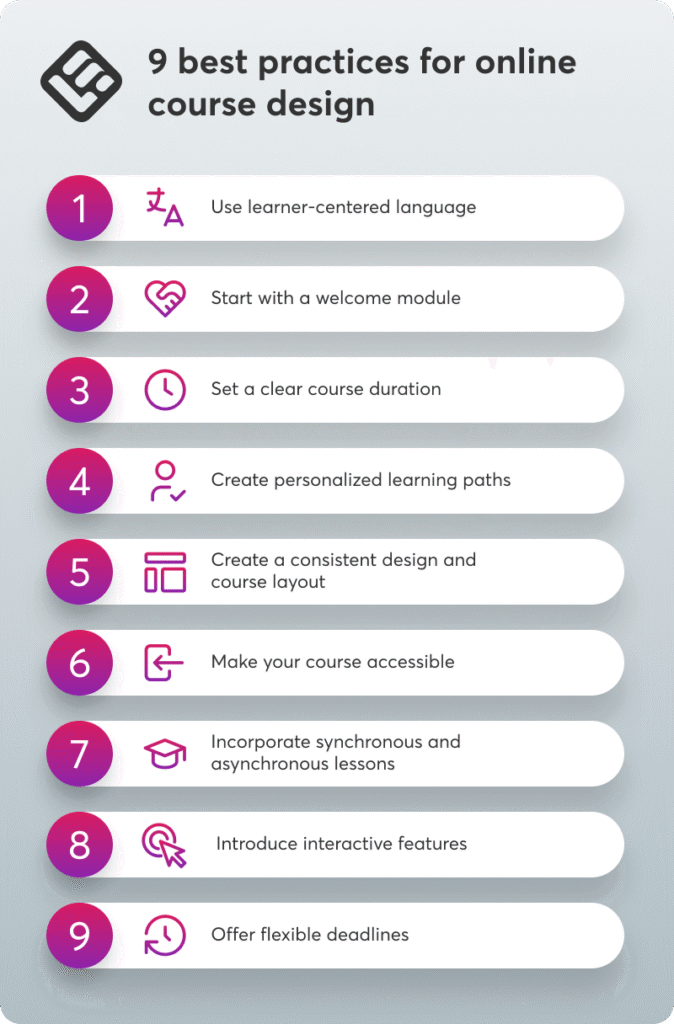Table of Contents
Building a great online course structure is like making a sandwich – an analogy that might seem weird at first, but stick with me; this analogy is juicy.
Imagine your course content as the filling, rich and meaty. Now, think of the course structure as the bread that holds it all together.
Just as a soggy piece of bread can ruin the most delicious ingredients, if you just throw everything in, you might end up with a poorly structured online course that leaves learners feeling like they’ve bitten into a virtual mess sandwich.
But if you follow the right course creation recipe, your online course can be the delicious, well-structured sandwich of learning, with each layer building on the other, just like a gourmet sandwich.
So, to create an online course structure that’s more tasty than a perfectly toasted slice of bread, we’ll share 89 best practices for online course design that will turn your online education into the kind of experience learners will crave, even ask for seconds.
Why online course design matters
A well-designed course grabs the learners’ attention, guides them through the content in a logical and intuitive way, and helps them apply what they’ve learned. When design is neglected, even the best content can fail, cause confusion, disengagement, and poor learning outcomes.
In fact, according to a 2024 IBO study, designing online courses intentionally can improve learning outcomes and increase students’ success.
Good course design also means accessibility, inclusivity, and adaptability. It takes into account different learning styles, varying levels of digital literacy, and different schedules to make education more equal and learner-centric.
9 online course design best practices to optimize your online course structure
We’ve researched and analyzed dozens of educational sources and consulted with course design experts from LearnWorlds to distill the most effective strategies for building an awesome online course structure. Just as in life, efficiency is key.
Let’s get started.
1. Use learner-centered language
Use learner language in the structure and content of your online course syllabus to make the learning experience better for your students.
By using learner language, you can create more engaging and inclusive course materials and a learning environment that caters to the diverse needs and preferences of your students.
A learner-centered approach in your syllabus means framing course objectives, expectations, and instructions from the student’s perspective. This means using language that emphasizes their active role in the learning process, encourages autonomy, and aligns with their motivations and goals.
💡 Here’s how you can practically apply this best practice for online course design.
Course objectives
Instead of listing what the course will cover, express the learning outcomes and learning objectives in a way that highlights the benefits and relevance to the students. Start with what you want your students to be able to do by the end of the course.
💁 For example, you can frame an objective like “By the end of this training course, learners will be able to critically analyze complex issues” as “By the end of this online course, you will be able to create a podcast series about social media marketing for course creators.”
Expectations
When outlining expectations, use language that emphasizes the role of students in meeting those expectations.
💁 Instead of saying, “Assignments must be submitted on time,” you can say, “Your commitment to submitting assignments on time is crucial to your success in this high-level training.”
Assessment
Describe the assessment methods and criteria with clarity, and convey how these learner assessments will benefit the students. Use multiple assessment methods (eg quizzes, tests, essays, and projects). This will help you to measure student learning and progress.
💁 For example, “Graded discussions will help you improve your communication skills and deepen your understanding of course concepts.”
Feedback
Highlight the value of feedback as an opportunity for growth and improvement.
💁 Instead of saying, “Feedback will be provided on assignments,” you can say, “We will provide real-time feedback on your assignments to support your learning and progress.”
Resources
Provide a comprehensive list of elearning resources and tools, and make it clear how each resource will help the students in their learning journey. This type of content might include textbooks, articles, videos, or other materials.
Communication
Encourage student engagement and communication between learners and instructors. Use language that fosters a collaborative and supportive learning community.
Accommodations
Be inclusive by including a section on accommodations for learners with specific needs. Use this online course design best practice to show your commitment to creating an equitable learning environment.
2. Start with a welcome module
The “welcome module” is the first thing your online students will see in your course. It’s like the course introduction, and helps your learners understand what the course is all about.
💁 For example, you can include a learning activity that says: “In this module, you’ll get a sneak peek of the course outline (that’s the syllabus), and there’s also a cool activity to get you thinking positively.”
The purpose of this welcome module is not just to say ‘hi’ but to get your learners excited and ready for the course. It presents them with:
Plus, it breaks down how the course will work, like when assignments are due and how they’ll be graded.
You can think of the “welcome module” as a way to kick things off positively and build a sense of community with your online students and the instructor.
3. Set a clear course duration
The duration of your course is a key consideration, and you have to make it clear right from the start to effectively design an online course. It’s a critical factor if you want to ensure a great learning experience.
To maximize engagement and understanding, you need to structure your course in bite-sized chunks.
One of the guidelines for setting the course duration is to break your modules into short segments, each no longer than 30 minutes. This aligns your content delivery with your learners’ attention span.
By doing this, you set clear and achievable expectations for your audience about the amount of time they will need to dedicate to their learning. Also, you’re making it easier for them to focus on the learning process and grasp and retain the content, no matter the subject or learning style you’ll use.
4. Create personalized learning paths
Crafting customized learning paths and integrating them into your online course isn’t just about education; it’s about creating meaningful connections with your learners and turning the learning journey into an adventure.
By designing these personalized pathways with learning engagement automations, you’ll enable your learners to embark on their own learning quests with enthusiasm and purpose.
Personalization Redefined: 17 E-learning scenarios
Think of your online course as a treasure map rather than a textbook. A well-structured course isn’t just about offering knowledge; it’s like designing a video game, with quests and secret treasures.
When you create personalized learning paths, you’re essentially building a Choose-Your-Own-Adventure story where each learner is the hero.
Your learners, like explorers, come with their own interests, preferences, and abilities. With personalized learning paths, you give them the power to navigate through the course like a true hero, picking the challenges they’re most interested in and the skills they want to acquire.
To make it even more fun, think of adding to your online course structure strategies like unlocking achievements and earning badges. Offer ‘side quests’ or bonus content for those who want an extra challenge, like hidden bonus levels in a game.
And, of course, keep communication clear and friendly like a user-friendly video game interface. Give them a roadmap to their personalized learning journey, and explain the benefits of customization – better learning outcomes and a more enjoyable learning adventure.
💡 Watch our on-demand webinar and learn how to transform your online teaching and online course creation with learning-centered microflows tailored to your audience’s needs.
Use a learning management system (LMS) to organize and deliver your course. LMS features like online forums, assignment submission, and grade tracking enhance the learning experience.
5. Create a consistent design and course layout
Consistency in your online course structure and overall course design is key to an improved learning experience.
When your lesson plan has a clear structure, it’s easier for learners to follow and understand the course content. Not only is learning more enjoyable, but also more engaging, improving retention.
Here are three tips for implementing this best practice for online course design:
Maintain a uniform design and layout throughout your course. Clear headings, subheadings, and bullet points, along with multimedia content, can improve the visual appeal and make navigation easy.
6. Make your course accessible
Accessibility should be part of your course creation process, not an afterthought. Research conducted by the OLC/WCET (2019) revealed that 68% of participating institutions said they didn’t know how to address accessibility. This was one of the main challenges they found in developing digital courses.
Inclusive design, though, means learners of all abilities, devices, and backgrounds can engage with your content without any difficulty.
That includes adding elements such as:
When you are ensuring accessibility from the start, you are increasing your audience and learner equity.
Following online course design best practices means considering a wide range of learner needs, including those with visual, auditory, motor, or cognitive impairments. When your course is easily accessible, it not only meets legal standards (like WCAG or ADA compliance) but is also easier to use for everyone and improves the overall learning experience.
7. Incorporate synchronous and asynchronous lessons
Blending live (synchronous) and on-demand (asynchronous) content creates a dynamic and flexible learning environment. Synchronous sessions, like live webinars, Q&As, or workshops, allow real-time interaction and a sense of community and accountability. Asynchronous content lets learners study at their own pace through pre-recorded lessons, readings, and self-paced quizzes.
This hybrid structure is what effective online courses aim for: a balance between autonomy and support. While asynchronous learning provides flexibility, synchronous touchpoints offer the immediacy and connection often found in face-to-face settings. Together, they come to enrich the online learning experience and cater to different learning preferences.
💡Read also: What is blended learning: Why it matters and how to apply it
8. Introduce interactive features
Interactivity is one of the most powerful tools to keep learners engaged and motivated, as this study by Cornell University shows. Consider adding to your course interactive elements such as:
These tools can turn passive viewing into active learning and encourage critical thinking, immediate application, and knowledge retention.
When you design an online course, make sure you add these interactive elements strategically in places that can reinforce key concepts, provide feedback, and personalise the experience. Whether it’s a quick knowledge check or a peer-reviewed assignment, interaction makes the course more memorable and participatory, key traits of effective digital learning.
9. Offer flexible deadlines
One of the most loved things about online learning is flexibility, especially for adult learners juggling work, family, and studies. Rigid schedules can discourage participation, increase dropout rates, and create unnecessary stress. By offering flexible deadlines, you’re giving learners the ability to progress at a pace that suits their unique circumstances.
While structure is important, allowing for extensions, grace periods, or rolling enrollment means learners can manage their time and complete. By ‘flexibility’ we don’t mean lowering any standards—instead, removing barriers and supporting learner success.
Online course design: What’s bad and what’s good
Building a great online course is about creating an experience that’s engaging, efficient, and accessible. Bad design can overwhelm, frustrate, or alienate learners, while good design brings clarity, motivation, and deep understanding.
Knowing the difference between bad and good course design is key for any instructor or course creator who wants to make an impact.
The best online course design balances content, usability, and interaction. It anticipates learner needs, supports different learning styles, and promotes progress without cognitive overload.
In the tables above, we show what bad and good course design mean, highlighting the common pitfalls in course design and what to focus on instead.
💡Read also: 13 things to consider when determining the value of your online course
Cook up effective online courses with LearnWorlds
Crafting effective online courses is like cooking a sandwich, and in this post, we’ve given you the recipe for an educational feast.
Each tip is a dash of excitement.
The welcome module is the appetizer, and personalized learning paths turn your course into an adventure with achievements and bonus content is the cherry on top. Consistent design is the secret seasoning, so your course is a mix of flavors and experiences.
Gear up, follow this recipe of best practices for online course design, and serve a course that keeps learners hungry for more.
Don’t forget your trusty sidekick, the learning management system (LMS), to streamline the experience.
Get started with LearnWorlds’ 30-day free trial for an extra boost.
Rosemary is LearnWorlds’ Content Marketing Manager. She has over 2 decades of experience in omnichannel marketing and content writing for the IT and SaaS industry. Her expertise lies in crafting effective content marketing strategies that attract, engage, and nurture customers, enabling LearnWorlds to reach its target audiences with precision.
Kyriaki is the SEO Content Manager at LearnWorlds, where she writes and edits content about marketing and e-learning, helping course creators build, market, and sell successful online courses. With a degree in Career Guidance and a solid background in education management and career development, she combines strategic insight with a passion for lifelong learning. Outside of work, she enjoys expressing her creativity through music.
FAQ
Everything you have ever wondered, but were too afraid to ask...
Here’s how to structure an online course:
Here’s how to launch an online course step by step:
Here are the key elements of a good online course:
Here are a few ways you can help them succeed:




